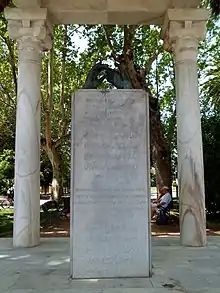| Wallada bint al-Mustakfi ولادة بنت المستكفي | |
|---|---|
| Born | Wallada bint Muhammad 994 or 1001 Córdoba, Caliphate of Córdoba |
| Died | 26 March 1091 Córdoba, Taifa of Córdoba |
| Resting place | Córdoba, Spain |
| Dynasty | Umayyad |
| Occupation | Poet |
Wallada bint al-Mustakfi (Arabic: ولادة بنت المستكفي) (born in Córdoba in 994 or 1001[1] – 26 March 1091)[2] was an Andalusian poet and the daughter of the Umayyad Caliph Muhammad III of Córdoba.
Early life
Wallada was the daughter of Muhammad III of Córdoba, one of the last Umayyad Cordoban rulers, who came to power in 1024 after assassinating the previous ruler Abderraman V, and who himself was assassinated two years later in Uclés. Her mother was an Iberian Christian slave. Her early childhood was during the high period of the Caliphate of Córdoba, under the rule of Al-Mansur Ibn Abi Aamir. Her adolescent years came during the tumultuous period following the eventual succession of Aamir's son, Sanchuelo, who in his attempts to seize power from Hisham II brought the caliphate into civil war. As Muhammad III had no male heir, Wallada inherited his properties, and used them to open a palace and literary hall in Córdoba. There she offered instruction in poetry and the arts of love to women of all classes, from those of noble birth to slaves purchased by Wallada herself. Some of the great poets and intellectuals of the time also attended.
Image and artistry
Wallada was an ideal beauty of the time, intelligent, cultured and a litterateur. She also was somewhat controversial, walking out in public without a veil and in the fashion of the harems of Córdoba, and wore transparent tunics. Her behavior was regarded by the local Imams as perverse and was strongly criticized, but she also had numerous people who defended her, such as Ibn Hazm, the famous author of The Ring of the Dove. Wallada gained recognition for her poetry skills, particularly as a woman in what was a male-dominated field.
One example of Wallada's work and audacious character is her "Ana Wallah Asluh lil maʿali'" (I am, by God, fit for high positions), which verses she had embroidered in gold on the trim of her robe. The poem is in the wafir metre.[2]
أَنَا وَاللهِ أَصْلُحُ لِلْمَعَالِي |
I am, by God, fit for high positions. |
Relationship with Ibn Zaydun

A Cordovan custom of the time was for poets to compete in finishing incomplete poems. It was during one of these poetry competitions that Wallada met Ibn Zaydun. Zaydun was also a poet and a nobleman who had been making measured political strides towards Cordoba. Because of this and Zaydun's ties with the Banu Yahwar — rivals of her own Umayyad clan — their relationship was controversial and had to remain a secret.
Eight of the nine poems preserved from Wallada were written about their relationship, which apparently ended under contentious circumstances. Written as letters between the two lovers, the poems express jealousy, nostalgia, but also a desire to reunite. Another expresses deception, sorrow and reproach. Five are sharp satires directed against Zaydun, whom she accuses of, amongst other things, having male lovers. In one writing, it was implied that the relationship ended because of an affair between Zaydun and a "black lover". Some say that the lover was a slave girl purchased and educated as a poet by Wallada, as she herself suggests, while others speculate that it could have been a male. A third possibility is that the poem was written in congruence with the times, as infidelity with black lovers was a common theme in Arabic poetry.[4] The last of the nine poems alludes to Wallada's liberty and independence.
After her split with Zaydun, Wallada entered a relationship with the vizier Ibn Abdus, who was one of Zaydun's major political rivals. Abdus, who was completely enamored with Wallada, would end up seizing Zaydun's properties and having him imprisoned. Soon afterwards Wallada moved into the vizier's palace, and although she never married him, he remained by her side until his death, well into his eighties.
Legacy
Among Wallada's most outstanding students was Muhja bint al-Tayyani, the young daughter of a fig salesman, whom Wallada welcomed into her house. After Wallada's death, Muhja would go on to write a number of kind satires about her.
References
- ↑ Denton, Chad (2014-11-05). The War on Sex: Western Repression from the Torah to Victoria. McFarland. p. 105.
- 1 2 "Mujeres andaluzas. Biografia. Mujer historia feminismo Andalucia". www.historiamujeres.es (in Spanish).
- ↑ Medievalists.net (2022-04-21). "Fit for High Positions: The Life of Wallada bint al-Mustakfi". Medievalists.net. Retrieved 2023-06-05.
- ↑ Wallada: A Fateful Woman of the 11th Century (in Spanish), Segunda Republica January 24, 1999. Retrieved 2007, 04-07.
Other sources
- Dozy, R. P. Historia de los musulmanes en España . Madrid, Turner, 1988.
- Garulo, T. Diwan de las poetisas andaluzas de Al-Andalus. Madrid, Ediciones Hiperión, 1985.
- López de la Plaza, G. Al-Andalus: Mujeres, sociedad y religió. Málaga, Universidad de Málaga, 1992.
- Sobh, M. Poetisas arábigo-andaluzas. Granada, Diputación Provincial, 1994.
External links
- Andalucia.com article
- A Biography of Wallada (in Spanish)
- Another Biography (in Spanish)
- Project Continua: Biography of Wallada bint al-Mustakfi Project Continua is a web-based multimedia resource dedicated to the creation and preservation of women’s intellectual history from the earliest surviving evidence into the 21st Century.
- Portrait of Wallada by J.L. MUÑOZ